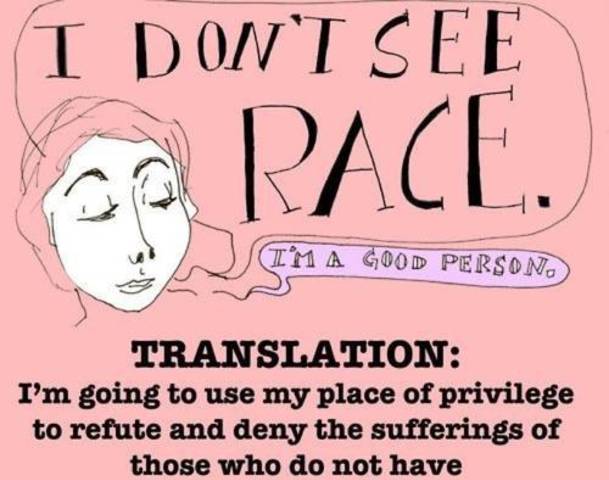1."Peggy Mcintosh describes it, privilege exists when one group has something of value that is denied to others simply because of the groups they belong to, rather than because of anything they've done or failed to do" (23). Johnson believes that it is important for us to realize and notice the problems in order to fix them. To do so, it is important for us to first understand the idea of privilege itself, whether we belong to a privileged group or not. (As we know the privileged groups in society fall under the categories of Straight, Christian, Whiteness, Able-bodiedness, American-ness, Maleness, and Property Ownership) Sometimes it is easier for those of us that have the luxury of falling into these valued categories to pretend that privileges don't exist, however Johnson stresses that we must recognize and accept that privilege is a problem that exists if we want to make a change.
2. "No, her misfortune is connected to my fortune; the reality of her having to deal with racism and sexism is connected to the reality that I don't" (8). In this quote, Johnson is talking about his female African American colleague, and he realizes that there are misfortunes that she must deal with because of her sex and race that he does not have to worry about because he is a white male. Johnson states that there are two sides to privilege, the fortunate end of privilege as well as the disparity of privilege, and that the two are connected to each other. Those who have to deal with the disparity of privilege in groups is due to the fact that those who are privileged do not have to. Meaning, it is important for us to realize that WE are all part of the problem.
3. "And if people in privileged groups don 't include themselves in the solution, the default is
to leave it to blacks and women and Asians, Latinos, Native Americans, lesbians, gay men, and the lower and working classes to do it on their own. But these groups can't do it on their own, because they don't have the power to change entrenched systems of privilege by themselves. If they could do
that, then: wouldn't be a problem in the first place" (10). Johnson states that those who are privileged need to use their privilege in society to help make a change. People without power can not make a change alone, and as Johnson states if they could there wouldn't be a problem in the first place. We need to change our mind set from "THEIR problem" to "OUR problem." Johnson uses the example that men tend to leave sexism as a problem for women to deal with on their own, as well as whites tend to leave racism as an issue for people of color to deal with. He stresses that we ALL must fight for equality for each group to truly make a difference.
4. "...if we dispense with the words we make it impossible to talk about what's really going on and what it has to do with us. And if we can't do that, then we can't see what the problems are
or how we might make ourselves part of the solution to them"(2). In this quote, Johnson highlights the importance of using words such as racism, sexism, privilege, heterosexism, classism, white racism, etc. that may make some people uncomfortable and even offended (especially those who are privileged). But he stresses how important it is for us to use these words and name our problems. By naming our problems we are recognizing their existence, and by doing this it draws our attention to it and one can start to think about it and start to produce solutions to solve it.
5. "Individuals are the ones who experience privilege or the lack of it, but individuals aren't what is actually privileged. Instead, privilege is defined in relation to a group or social category. In other words, race privilege is more about white people than it is about white people." (34). Johnson describes that being privileged has nothing to with the individual, and who you are as a person. It is rather given to us based on the groups that are valued in our culture that we are placed in (Whiteness, Straightness, Maleness, etc.) Meaning, you only have access to this privilege when people identify you as being part of one of these categories. Also, meaning that an individual can lose their privilege if others think that they don't belong to one of these valued category. This is why many people are ignorant to the fact that they are privileged, constantly using the phrase "Well I don't feel privileged", because being privileged has nothing to do with the individual but the category that individual is placed in society.












